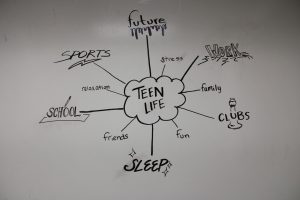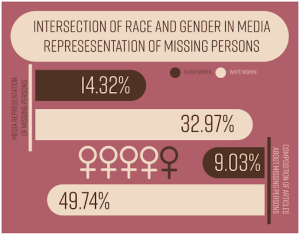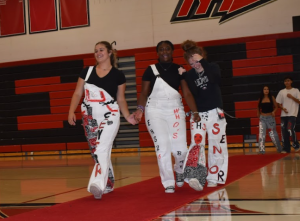Desensitization and Mental Health
March 5, 2018
I didn’t know what to write at first. How I could use my words to make students who are already desensitized to this world and it’s horrors understand that while laughter is the best medicine it isn’t the cure. Today many kids find it so easy to dismiss seemingly harmless jokes regarding mental illnesses without any second thought. Ranging from “I want to die” to just putting a finger gun up to their head, students don’t realize the effect of these jokes on themselves and others. The world has created a stigma regarding mental illnesses that makes students who need help believe it means they are broken and less than human. Our culture has made the outreach of children seem as though it’s wrong and it has become a taboo topic in many households. However that shouldn’t be the case in a place we go to learn and grow, yet the very people who suffer from these illnesses are the ones who laugh it off and make it seem like a joke. I have been a culprit of all of this, but it doesn’t excuse the behavior.
Ray King stated, “Society has a stigma around mental illness that it makes you weird or a freak, but for people who actually deal with it, it’s very difficult because I can’t do a lot of things other people do.”
Human beings shouldn’t be shamed because of chemical imbalances in the brain starting from birth to hormone imbalances as a teen to traumatic events. It does not mean that someone is broken or just stressed or simply a little down. It’s a constant voice that’s pointing out all of your flaws or a cloud hovers above your head and paints the world gray. There are so many layers involved, but so many take it at face value and even laugh at it. Laugh at jokes regarding serious illnesses like depression and anxiety.
Everyone has begun to ignore the real warning signs these jokes provide because its become apart of our culture. I know I’ve done it. I know I never actually planned on doing anything as severe as killing myself, but no one asked if I was serious when I said it. Years ago I shuddered putting a finger gun up to my temple, but these days I do it at least twice a day when I’m stressed or the slightest bit upset. Mental illness is not the butt end of your joke.
Barbara Edwards, one of the schools psychologist, explained, “There is a fear around mental health in general or just the fear of being able to be honest about not being ok.”
The school barely provides resources for students. Before I wrote this, the care line wasn’t even on the homepage, and no links about how to get mental help could be found under any tab. The mental health team at school does personally provide resources to students who may reach out.
Tracy Blizil, the school social worker, stated, “In the school building we have a school based therapist if that’s the direction the student and family want to go. We don’t do therapy because there’s almost three thousand kinds in the building and we don’t have time.Arapahoe Douglas Health and Aurora Mental health are the two I always refer because they have so many therapists and locations.”
Students do have some ways to get support from the mental health staff by getting coping strategies from classroom struggles to bringing things up at home.
Blizil continued, “I can offer very brief solution focused help. It’s kind of what we do at the school at this level.”
It’s become more common for students to reach out for help, because awareness of mental health is spreading, however knowing when a problem is real and when it’s a joke even slows teachers from talking to students.
Blizil explained, “Kids can become desensitized to it and so can staff. That is scary to me because I don’t want anyone to never take it seriously. When kids say things that people don’t think are true they have a difficult time telling what’s really going on.”
The problem is it becomes hard to differentiate between when someone wants people to laugh and when they need support. Edwards went on to talk about how students have so much going on in their lives from their backgrounds, to their sexual orientation, to even they classes they pick. All of these can bring about the ridicule of other students a lot of anxiety trying to complete everything. When someone mentions this anxiety however, a lot of people push it aside because everyone deals with it. Students need to be aware when there is a larger issue going on and it isn’t something everyone deals with.
Edwards stated, “There is going to be some anxiety. If it gets to the point though where it’s interfering with your day to day. If you’re not sleeping because you’re worried about it. If you’re not eating. If you’re not doing the things you normally do that is kind of a clue that ‘hey this may be a bigger issue.’”
Students, however, don’t want to go to help if they need it because they feel there isn’t any connection with those they are speaking to. No one wants to be open and personal to people who don’t strive to make a personal connection.
Tessa Giles elaborated, “I feel that we have wonderful counselors and people to help us, but there is no personal connection to them and that’s a really big part of it. No one is comfortable talking to random people about these very serious issues they may have.”
In health class, teachers and students alike laugh as we discuss mental illness. More often than not in classes mental illness is chalked up to an unspeakable problem or a joke, when those who personally deal with it and have experienced first hand the effects know how hard it can be.
Giles stated, “The mental health issue is becoming bigger and people are beginning to understand this is a thing that is happening. But there is definitely still the people who make jokes and the people who believe it’s a negative thing.”
While awareness is spreading and students have been known to reach out more, they are still hesitant. For many students there is no real connection, and more often than not it feels as though we are just here to graduate.
King stated, “I don’t think schools really care, they want you to pass your classes and if you’re not doing that they blame it on you slacking when you mentally can’t do it.”
The stigma and jokes don’t help however, because staff don’t notice when to reach out to a student.
Blizil stated, “A downfall of joking is it downplays anxiety or suicidal thoughts and students think ‘oh it’s happening to everybody’ when it’s really not. Or they may not take it as seriously if everyone is saying it.”
Several teachers have been pointed out for the support they offer students and the connections they make. This provides an outlet for students because to a few we aren’t just numbers and grades. We are students with thoughts and problems and sometimes we need someone to listen and actually care.
Heather Fraase stated, “ For me, building relationships is intentional. I’m invested in the students as much as I am invested in their learning. Students need to know they are valued. I do this by learning their names quickly and by asking them questions about their lives outside of school.”
Students tend to be more open with teachers who actually try to show it isn’t just about the class. If they aren’t being valued or treated as equals, students would feel insecure about asking for help due to the stigma that makes them appear weak.
Faith Vigil however doesn’t focus on that. She tries to make each of her students apart of her family and truly connect with them.
Vigil stated, “I talk to my students. I ask them how their day is going. If they’re upset, I try to comfort them. In return, I let my students know what I need. If I’m struggling with something, I’m honest and let them know. I think they appreciate that we can be open and honest with one another.”
It’s about open dialogue and being able to be honest with one another. Everyone has their own problems, but as a school many teachers and staff need to get into the mindset that connecting with students personally and being able to be vulnerable will allow students to be vulnerable back.
Fraase put it simply, “People do not learn when they are under stress, when basic needs aren’t being met, etc. It is only when there are connections between teachers and students that teachers can recognize when students are not learning and need additional assistance.”
In some ways Eaglecrest is doing all that they can. The school can offer many ways for students to connect on campus such as clubs and events to bring everyone together.
Vigil remarked, “I’ve always believed that one of the best things about Eaglecrest, is that we do a good job of making a big school seem small. What I mean by that, is that there is an outlet for every kind of kid.”
Sometimes a chance for students to come together isn’t enough, and they need to be able to turn to an adult who can guide them. More often than not students don’t have someone to turn to and connections are being made.
Edwards explained, “This is my first year at Eaglecrest and so I do know that is a part of a community of kids who feel that way, trying to get their voices heard.”
Those working for the school can see problems with being a type of therapy for students. The staff wants to be able to support students, but a teachers job isn’t to be a therapists, it’s to educate.
Karen Slusher explained, “We try to follow up, but sometimes we hit roadblocks. We aren’t a hospital. We can’t institutionalize kids if we have concerns. We can do our best to offer support, but the fact of the matter is our job is to educate.”
A low mental health budget, a lack of resources and confidentiality laws cause many unforeseen problems. This can put in a lot of roadblocks for the staff.
Slusher furthered that by saying, “Some of that comes back to families too. We can’t give you the counseling here that you need because that’s not what the role is. If you’re family doesn’t take it, then that gets lost.”
Edwards did shed light on the underfunding, many times teachers want to spend more time with students, but there isn’t enough time to and with only so many people in the department there isn’t enough energy being put into students.
Edwards stated, “Not enough time prevention. What is mental health and how to cope with it. That would be the idea to be able to do that more. However if you look at the funding buildings are given for mental health, some parts of our job we do what we have to do. If we had more funding and more mental health people in the building that would free up some of that time so we could do more direct work with students.”
There are multiple reasons for the problems around mental health and support at school. Which is the biggest obstacle, because something as big as students safety and health can not be shrouded in mystery. All of the misconceptions mean little focus is being put on students who may need help, but won’t ask for it. Students begin to feel that they get pushed aside with their problems being chalked up to teen angst. There needs to be some form of transparency. The staff needs to acknowledge we as a student body won’t seek out help if no one is seeking us out. Administrators need to understand that the sports teams don’t need more funding, because no one will be able to play if they don’t have a strong mental foundation. If we can create an open environment where no question is too far out of line and every teacher can make a close and personal connection to at least one student, then finally students can feel they are in an environment that cares more about their emotions and mental health than just passing a class.






